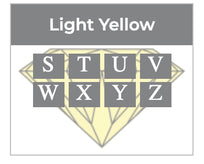A Brilliantly Simple Guide
Diamond Education: What You Need To Know.
The process of buying a diamond should be fun and exciting, not intimidating. That’s why we want to share our diamond expertise with you. Here’s an overview of diamond terminology, highlights and important facts. Enjoy!
Shape
The shape of your center diamond affects the way your ring looks and feels. Each shape has unique properties to consider when you’re choosing a diamond.

Round Brilliant
The most popular; cut for maximum brilliance.

Princess Cut
The most popular fancy-cut; has a great deal of sparkle.

Oval
A modified brilliant-cut with similar fire; elongated shape creates the illusion of greater size.

Cushion
A square cut with rounded corners, much like a pillow; arguably giving the most sparkle.

Asscher Cut
An elegant square shape with blocked corners that make diamonds appear octagonal.

Emerald
Rectangular with parallel facets and blocked corners; produces a hall-of-mirrors effect.

Marquise
An elongated shape with tapering points at both ends; flatters the finger.

Pear
Teardrop-shaped, with a great deal of sparkle.

Radiant Cut
A combination of the emerald cut and the round brilliant; typically with blocked corners.

Heart
A sentimental cut that is sometimes hard to find.
Understanding The Four Cs.
CUT – It’s a big deal
Cut is what gives a diamond its sparkle.
It is the only aspect of a diamond controlled by man. It’s the man-made cut that expresses the diamond’s natural sparkle and has the biggest impact on your diamond’s appearance and quality. That’s why we suggest you invest in a quality cut grade first and foremost. It’s not that carat, clarity and color are unimportant, but sacrificing sparkle for a larger diamond, or one that’s color can only be distinguished under magnification, isn’t the best choice.
As important as cut is, no standardized criteria for cut grading existed before the mid 20th century. When criteria were finally standardized, it included brightness, fire, scintillation, weight ratio, durability, polish and symmetry. A cutter who is working with a diamond rough is trying to maximize each of these to make the diamond more rare and valuable. Needless to say, it takes a master level of craftsmanship to achieve maximum sparkle.

So what’s best? A diamond cut with the ideal proportions for its shape. Think of it like this: The bottom of the diamond has facets, and those facets act like mirrors. When the facets are cut at the proper angles, light enters through the top of the diamond, bounces off the mirrors, and returns back to your eye in a full spectrum of color.
The opposite is true for a poorly cut diamond with incongruous proportions. It will allow light to escape out the bottom and sides, resulting in a dull, dark appearance.
In short, the angles allow the diamond to capture and reflect light or sparkle. For a really brilliant diamond, with excellent polish and symmetry, you should choose a cut grade of Very Good or Ideal. Always remember that perfection in cut will also increase your diamond’s value, making it, so to speak, a cut above the rest.
COLOR – Less is more
Just because a diamond looks white doesn’t mean it’s colorless. In fact, the white diamond spectrum ranges from totally colorless to light yellow. The amount of color in a diamond is signified with a special lettering system that ranges from D to Z. The letter D is awarded only to rare, totally colorless diamonds. In other words, the more colorless a white diamond is, the greater its beauty and value.
Colored diamonds, such as pink, blue, chocolate or bright yellow, are also available, but they are rated on a different scale than white diamonds.
- A colorless diamond can be graded D, E or F. Less than ¼ of 1% of all the diamonds in the world fall into this category.
- A near colorless diamond can be graded, G, H, I or J. The majority of diamonds sold in the industry are represented by one of these grades.





CLARITY – Clearing up the mystery
The number, size, nature and position of its inclusions and blemishes determine a diamond’s clarity. No diamond is perfect, but the closer it comes to perfection, the higher its value. A “flawless” diamond is rare. Inclusions seldom affect a diamond’s beauty, although they do affect price.
Part of the wonder of diamonds is the fact that they are created by incredible natural forces. In fact, natural diamonds are formed by tremendous heat and pressure deep within the earth. Understandably, the powerful process can result in internal “inclusions” and external “blemishes.” These are simply fancy words for imperfections, or characteristics, as we like to call them.





CARAT WEIGHT – Beyond size
This one may seem fairly self-explanatory. But there are a few things you need to know. Carat weight is a measure of a diamond’s weight, and a reflection of its size. So two diamonds of slightly different sizes may have the same carat weight. Size also depends on how evenly weight is distributed and the quality of the cut. So two diamonds with the same carat weight can vary greatly in value, depending on the color, clarity and most importantly, the cut. It’s really a matter of deciding what matters most to you, size or quality, and then finding the best combination of size, color and clarity for your budget.

